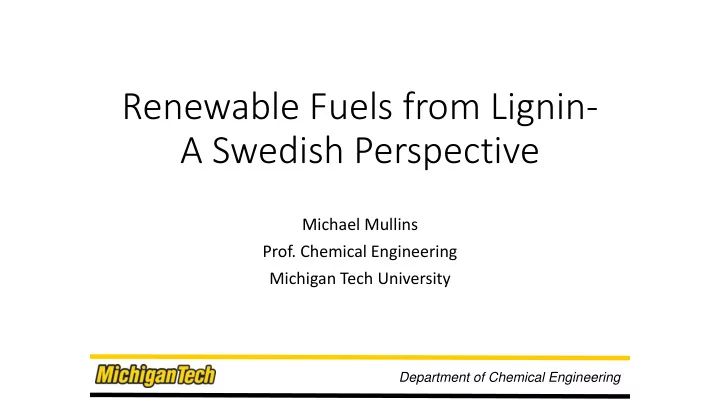

Renewable Fuels from Lignin- A Swedish Perspective Michael Mullins Prof. Chemical Engineering Michigan Tech University Department of Chemical Engineering
What was I doing in Sweden? • Professor of chemical engineering at Michigan Tech for 30 years, Department chair for 6+ years. • Research emphases in thermodynamics, reactor design, and materials. • Selected as the Distinguished Fulbright Chair in Alternative Energy for Chalmers University (August, 2015 to June, 2016) • Additional research funding supplied by the U.S. National Science Foundation’s “Wood-to-Wheels” program. • To explore processes to produce renewable transportation fuels fully compatible with existing engines & the fuel distribution infrastructure. • Co-production of value-added chemicals (e.g. BTEX) Department of Chemical Engineering 2
Research Conducted in Sweden • Developed a collaboration with Chalmers, Valmet, and Swedish refiner Preem. • Preem currently produces >250,000 m 3 of renewable fuels/year, but needs additional feed materials to reach goal of >1M m 3 /year • Development and optimization of a pilot scale hydrothermal process for lignin depolymerization which produces a suitable bio-oil. • Experimental studies on catalytic HDO of depolymerization products to produce compatible transportation fuels with minimal coking. • Aspen simulation studies on phenolic extraction and separation. • Detailed process-level models to simulate and perform techno- economic analyses (TEA) and Life Cycle Assessments (LCA) for lignin- to-fuels process. Department of Chemical Engineering 3
Hydrothermal bio-oil production Near-critical and Supercritical Water • Pyrolysis oil is a less than an ideal starting point for fuel production processes, due to small molecule size and oxygen content (>30wt%) • Hydrothermal liquefaction in near-critical water is promising due to larger molecules and low oxygen content (<13wt%) • Both hydrolysis and hydrogenolysis come into play. Thus it has the potential to create lower-oxygen oils (7 to 15 wt%). Typical appearance of • Higher molecular weight distribution than pyrolysis oil, aqueous (left) and oil making it more suitable for renewable diesel, and chemical phases (right) from the NCW process. production. Department of Chemical Engineering
Lignin Depolymerization • Due to energy efficiency measures in pulp mills, up to 30% of the lignin may be removed without impacting operations. (Valmet, Sodre Cell Varo) • Excess lignin doesn’t require additional wood harvests, and doesn’t complete with food supplies. • Takes advantage of existing collection capabilities and infrastructure. • Cleavages occurs at sites that produce monomers favorable for fuel and chemical production. 5 Paracoumaryl alcohol Coniferyl alcohol Sinapyl alcohol Department of Chemical Engineering
Chalmers University Process Catalytic Near-Critical Water Depolymerization of Lignin • Pilot plant uses a packed bed reactor with solid catalyst, plus recycle of the aqueous phase (3 – 5 kg dry lignin/hr). • Water just below the critical point is preferred to ensure the solubility of alkali salts and high pH. • Tests on lignin feed (LignoBoost) show yields of bio- oil ranging from 69 to 88wt% on a dry lignin basis, corresponding to between 140 and 175 gallons of bio-oil per ton of dry lignin . • High liquid yields due to small amount of gas-phase products (<2 wt%), minimal losses due to char on the catalyst and other suspended solids (12 - 15 Chalmers NCW pilot plant wt%). The balance is water soluble organics. Department of Chemical Engineering
Why catalytically upgrade? • Problems with bio-oil • Highly oxygenated (Pyrolysis oils approaches 40 wt% oxygen). • Corrosive (due to phenols and similar compounds). • Thermally and biologically unstable. • High viscosity and low cloud point. • Difficult to blend with traditional hydrocarbon fuels. • Formation of waxy deposits. • Via “upgrading” or hydrotreatment (HDT) of the bio-oil, these issues can be addressed - but at a cost. Department of Chemical Engineering 7
Hydrogenation Michigan Tech Methylation Hydrodeoxygenation HDO pilot plant Anisole Demethylation HDO pilot plant has a small pilot scale trickle- Phenol bed reactor. Cyclohexanol • Differential reactor used to study reaction Cresol Xylenol kinetics and pathways of surrogate Cyclohexane compounds and mixtures. Benzene Cyclohexene • Trickle-bed reactor uses co-current down flow configuration for high-conversion studies on surrogate mixtures and pyrolysis oils. • Results used to develop process-level reactor models for LCA and TEA comparison studies. • Serves as a screening tool for the next generation of HDO catalysts designed specifically for bio-oil HDO. Department of Chemical Engineering
Process simulation for integration of HTL and HDO with pulp mills and refineries to produce fuel and BTEX compounds. Key areas for improvement are shown in red. 9 Department of Chemical Engineering
Do bio-oils have a future in transportation fuels? • Renewables must take advantage of existing infrastructures to be viable. • Pulp and paper industry ready to work with fuel producers. (Valmet) • Refiners developing capacity to handle bio-oils, but composition should be appropriate for fuel production and have lower oxygen content (<10wt%). (Preem) • Sufficient feedstocks are not currently available, and hydrogen demand will drive prices. • A detailed techno-economic analysis and LCA needs to be completed. • Renewables should be environmentally, economically, and socially sustainable. • Should not compete with food supplies or other sectors. • Produce fuel at competitive prices without subsidies. • Not create artificial economies in underdeveloped areas. Department of Chemical Engineering 10
Recommend
More recommend